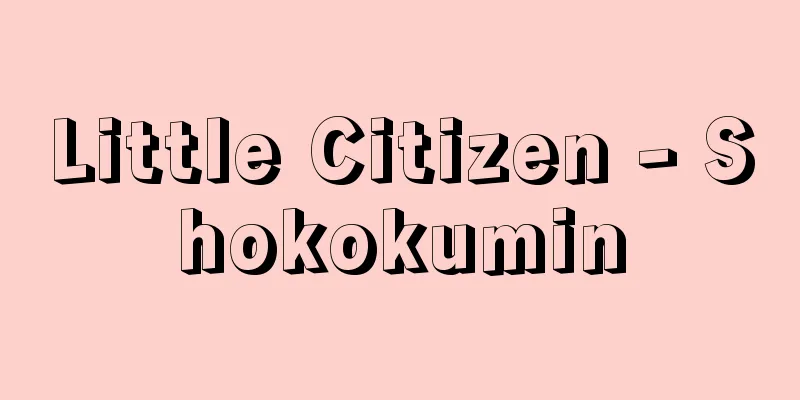Iemoto system

|
The head of a school of arts and culture is called an iemoto. The iemoto system is when the iemoto has the monopoly on issuing licenses and has created a grand iemoto culture society. The word iemoto first appeared in 1689 (Genroku 2) in the entry for July 26, 1713 (Shotoku 3) in the Nenkai Nikki (Annual Diary) of the Horyu-ji Ikaruga Bunko, where it meant a family that had the right to admit boys who would become monks after they reach adulthood to temples such as Horyu-ji, Todai-ji, and Yakushi-ji. There are also head families that protect the graves of their ancestors, head families of the origins of martial arts, and head families of merchants, but historically the most important are the head families of various performing arts schools. The first appearance of this performing arts iemoto was in Baba Bunko's book Kinsei Edo Chomonju (Collection of Stories from the Edo Period) in 1757 (Horeki 7). However, its actual origins lie in the Heian period, when various houses of gagaku music were established that belonged to nobles, shrines and temples, poetry houses such as the Nijo and Reizei families, and houses of chronicles, literary works and Onmyodo. During the Kamakura period, the Ogasawara family, known for archery and horsemanship, and the Takakura family, known for clothing and kimono, were established. From the Northern and Southern Courts period through to the turbulent Sengoku period, Noh and Kyogen families were established, as well as the Jodo Shinshu Honganji temple, and within aristocratic society, families of incense, calligraphy, singing, kagura (sacred music and dancing), eikyoku (traditional Japanese musical instrument), biwa (Japanese lute), wagon (Japanese harp), kemari (traditional Japanese lute), taka (traditional Japanese falconry), jingi (traditional Shinto music), costume, knife, and divination were all established. A system of licenses for secret teachings was established, and they were actively passed on. In the early 17th century, many samurai and aristocrats were created in castle towns throughout the country, and as they made visits to Edo, this large population of newly emerging samurai and aristocrats began to actively practice martial arts and recreational arts, and in addition to archery and horse riding, many schools of martial arts were established, including gunnery, swordsmanship, spearmanship, ninjutsu, judo, and more. Incense, tea, and flowers also saw an unprecedented prosperity, and words such as chado, kodo, and kadou came into use, and Japan's arts of the arts were established during this period. In the 18th century, many wealthy townspeople were born in the three major cities and in other cities throughout the country. These townspeople flocked to the iemoto's entertainment culture, actively performing tea ceremony, flower arrangement, haiku, music, and other arts, and the population of these people grew enormously. As this phenomenon took hold, training in the townspeople's society flourished, and the number of people hoping to receive their licenses directly from the iemoto increased. Eventually, the iemoto came to have a monopoly on the right to license, and a revolution occurred in the ancient method of license transmission. In other words, the ancient complete transmission format in which those who received the kaiden were given the right to further pass it on to their senior disciples was abolished, and town masters (natori masters) were given only the right to teach, and all licensing rights came to be monopolized by the iemoto. This was the iemoto system, which spread from the mid-18th century to various schools of tea ceremony, flower arrangement, incense ceremony, music, and other arts practiced among townspeople, and in the 19th century, the iemoto system was also established by families of the three instruments of gagaku, namely the sho, hichiriki, and flute. Furthermore, iemoto systems of various sizes appeared in all entertainment and cultural societies, including various schools of Japanese music. This system continued with little change after the Meiji era, but until around 1955, the majority of the iemoto system's members were made up almost entirely of men. In the 1950s, however, women flocked to all kinds of performing arts, and the iemoto system's cultural society was quickly monopolized by women, and in modern times, women have made remarkable inroads into not only tea ceremony and flower arranging, but also Nohgaku singing and performance. In Japan, there are many pseudo-iemoto systems that are similar in substance to the iemoto system, such as the Kodokan (Judo) and the Nihon Ki-in (Go), and the iemoto system, including these, has created a cultural society unique to Japan. [Matsunosuke Nishiyama] "The Iemoto System" by Kawashima Takeyoshi (included in "The Family System as Ideology", 1957, Iwanami Shoten)" ▽ "A Study of Iemoto" by Nishiyama Matsunosuke (1959, Azekura Shobo)" ▽ "Contemporary Iemoto" by Nishiyama Matsunosuke (1962, Kobundo)" ▽ "The Development of the Iemoto System" by Nishiyama Matsunosuke (1983, Yoshikawa Kobunkan)" ▽ "The Story of the Iemoto" by Nishiyama Matsunosuke (Chuko Shinsho) Source: Shogakukan Encyclopedia Nipponica About Encyclopedia Nipponica Information | Legend |
|
技能文化における一流一派の統宰者を家元という。その家元が免許状発行権を独占し、壮大な家元文化社会を構成したものを家元制度という。家元ということばの初見は、法隆寺鵤(いかるが)文庫蔵『年会日記』正徳(しょうとく)3年(1713)7月26日条によると、1689年(元禄2)で、法隆寺、東大寺、薬師寺などへ成人後僧となる少年を入寺させる権利を所持する家を意味した。また、先祖の墓を守る本家とか、武芸根源の本家、商家の根源本家などにも家元とよばれるものがあるが、史上重要なのは芸能諸流の家元である。この芸能家元の初見は、1757年(宝暦7)に成る馬場文耕(ぶんこう)の著『近世江都著聞集(こうとちょもんじゅう)』である。しかしその実体としての起源は平安時代にあり、公家(くげ)・社寺などに属した雅楽の家々、二条家・冷泉(れいぜい)家など歌の家、紀伝・文章(もんじょう)・陰陽道(おんみょうどう)の家などができた。鎌倉時代には、弓・馬の小笠原(おがさわら)家、衣紋(えもん)の高倉家などが成立、南北朝時代から戦国動乱期にかけて、能狂言の家や、浄土真宗の本願寺、ならびに、貴族社会に香、書、歌、神楽(かぐら)、郢曲(えいきょく)、琵琶(びわ)、和琴(わごん)、蹴鞠(けまり)、鷹(たか)、神祇(じんぎ)、装束(しょうぞく)、庖丁(ほうちょう)、卜筮(ぼくぜい)などの家が確立して、秘伝の免許体系を整え、盛んに伝授するに至った。17世紀初頭に全国城下町に多数の武家貴族が創出され、これが江戸に参勤することなどにより、この大人口の新興武家貴族が、武芸ならびに遊芸を盛んに稽古(けいこ)するようになり、武芸には弓、馬のほかに砲術、剣術、槍術(そうじゅつ)、忍術、柔術その他多くの武芸の家元が成立した。また、香、茶、花なども前代未聞(みもん)の隆盛をみるに至り、茶道、香道、花道などのことばが用いられるようになり、日本の芸道がこの時代に成立するに至るのである。 18世紀を迎え、三都を中心として、さらに全国の都市に富裕町人が多数成立すると、この町人たちが家元の遊芸文化に殺到して、盛んに茶、花、俳諧(はいかい)、音曲などを演じ、その人口は莫大(ばくだい)なものになっていった。こういう現象が成立するようになって、町人社会の稽古事(けいこごと)が隆盛化し、免許状を家元から直接伝授されることを希望する者が増大することとなり、やがて、家元が免許権を独占し、古代以来の免状伝授法に革命現象がおこることとなった。つまり、免許皆伝を受けた者は自分の高弟にさらに免許皆伝する権利をも与えられていた古代以来の完全相伝形式が否定され、町師匠(名取(なとり)師匠)は教授権のみを与えられ、いっさいの免許権は家元が独占するようになったのである。これが家元制度で、18世紀中ごろから町人社会に行われた茶道、花道、香道、音曲などの諸流に盛んに普及し、19世紀に入ると、笙(しょう)、篳篥(ひちりき)、笛などの雅楽三管の家々まで家元制度を結成するに至った。さらに邦楽諸流をはじめ、あらゆる遊芸文化社会に大小さまざまの家元制度が出現した。 明治以降もこの体制はほとんど変化なく存続したが、1955年(昭和30)ころまでは、これらの家元制度の大人口はほとんどすべて男性によって構成されていた。それが昭和30年代を迎えると、あらゆる芸能諸流に女性が殺到し、家元制度文化社会はたちまち女性に独占される状態となり、現代では、茶道、花道はいうまでもなく、能楽の謡(うたい)や演能にまで女性の進出は目覚ましいものがある。日本には、家元といわなくても、その実体が家元制度に酷似した講道館(柔道)とか、日本棋院(囲碁)、その他多くの擬似家元制度があり、これらをも含め家元制度は、日本独特の文化社会をつくりだしている。 [西山松之助] 『川島武宜著『家元制度』(『イデオロギーとしての家族制度』所収・1957・岩波書店)』▽『西山松之助著『家元の研究』(1959・校倉書房)』▽『西山松之助著『現代の家元』(1962・弘文堂)』▽『西山松之助著『家元制の展開』(1983・吉川弘文館)』▽『西山松之助著『家元ものがたり』(中公新書)』 出典 小学館 日本大百科全書(ニッポニカ)日本大百科全書(ニッポニカ)について 情報 | 凡例 |
>>: Iemochi Genin - Iemochi Genin
Recommend
Choya Shimbun - Choya Shimbun
A Tokyo daily newspaper launched on September 24,...
Onaruto - Oonarutto
…It was written as “Awa no Mito” in the ancient T...
Kanahebi - True lizard
In a broad sense, it is a general term for lizard...
Skin traction
...Direct traction (skeletal traction) is a metho...
Standard relative luminous efficiency
Also known as the standard luminous efficiency. Si...
Lake Pátzcuaro (English spelling)
A lake in the northern part of the state of Michoa...
Hard Base - Kataienki
[Synonym] Hard base Source: Morikita Publishing &...
Fukuwarai - Fukuwarai
A type of paper toy (gangu). It consists of a pie...
Wilson's theorem
The theorem proposed by the British mathematician ...
Almandine
...It is one of the important rock-forming minera...
Robert
…A descendant of the French Capetian dynasty. In ...
Six Jizo
[1][1] Buddhist term. Six types of Jizo Bodhisattv...
Glass beads
A manga by Fumiko Okada. A story about a boy who l...
San Francisco Bay - San Francisco Bay
A bay in central California, USA. It is 80 km long...
Sokodara - There
A marine fish belonging to the family Rattailidae...









